|
|
Venerable Ephraim the Syrian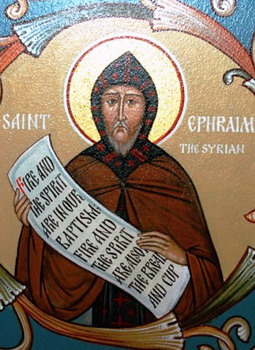 Ephraim was born in Syria of poor parents during the reign of Emperor Constantine the Great. He spent his youth rather tempestuously, but suddenly a change took place in his soul, and he began to burn with love for the Lord Jesus. Ephraim was a disciple of St. James of Nisibis (January 13). Due to the great grace of God, wisdom flowed from his tongue like a stream of honey, and ceaseless tears flowed from his eyes. Industrious as a bee, Ephraim continually wrote books, orally taught the monks in the monastery and the people in the town of Edessa, and dedicated himself to prayer and contemplation. Numerous are his books and beautiful are his prayers, the most famous of which is his prayer recited during the season of Great Lent: “O Lord and Master of my life, a spirit of idleness, despondency, ambition and idle talking give me not; but rather a spirit of chastity, humility, patience and love bestow upon me, Thy servant. Yea, O Lord and King, grant me to see my own faults and not condemn my brother; for blessed art Thou unto the ages of ages. Amen.” When they wanted to appoint him a bishop by force, he pretended to be insane and began to race through the city of Edessa, dragging his garment behind him. Seeing this, the people left him in peace. Ephraim was a contemporary and friend of St. Basil the Great. St. Ephraim is especially considered to be the apostle of repentance. Even today, his works soften many hearts hardened by sin and return them to Christ. He reposed in extreme old age in the year 378. Ephraim was born in Syria of poor parents during the reign of Emperor Constantine the Great. He spent his youth rather tempestuously, but suddenly a change took place in his soul, and he began to burn with love for the Lord Jesus. Ephraim was a disciple of St. James of Nisibis (January 13). Due to the great grace of God, wisdom flowed from his tongue like a stream of honey, and ceaseless tears flowed from his eyes. Industrious as a bee, Ephraim continually wrote books, orally taught the monks in the monastery and the people in the town of Edessa, and dedicated himself to prayer and contemplation. Numerous are his books and beautiful are his prayers, the most famous of which is his prayer recited during the season of Great Lent: “O Lord and Master of my life, a spirit of idleness, despondency, ambition and idle talking give me not; but rather a spirit of chastity, humility, patience and love bestow upon me, Thy servant. Yea, O Lord and King, grant me to see my own faults and not condemn my brother; for blessed art Thou unto the ages of ages. Amen.” When they wanted to appoint him a bishop by force, he pretended to be insane and began to race through the city of Edessa, dragging his garment behind him. Seeing this, the people left him in peace. Ephraim was a contemporary and friend of St. Basil the Great. St. Ephraim is especially considered to be the apostle of repentance. Even today, his works soften many hearts hardened by sin and return them to Christ. He reposed in extreme old age in the year 378.Venerable Isaac The Syrian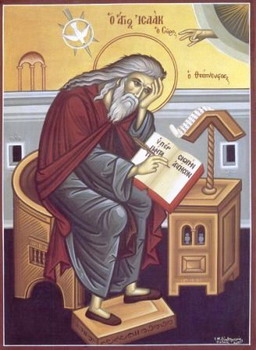 Isaac was born in Nineveh and in his youth lived an ascetical life in the Monastery of Mar [Saint] Matthew in the proximity of Nineveh. When Isaac became known because of the sanctity of his life and of his many miracles, he was elected bishop of Nineveh and was forced to accept that rank. But, after only five months, he left the bishopric and secretly withdrew into the wilderness to the Monastery of Rabban Shabur. He complied many works of which about a hundred homilies on the spiritual life and asceticism, written primarily from his personal experience, have come down to us today. He was unequaled as a psychologist and as a director in the spiritual life. Even such saints as was St. Simeon [the New Stylite] of the Wonderful Mountain near Antioch sought counsel from him. Isaac died in extreme old age toward the end of the seventh century. Isaac was born in Nineveh and in his youth lived an ascetical life in the Monastery of Mar [Saint] Matthew in the proximity of Nineveh. When Isaac became known because of the sanctity of his life and of his many miracles, he was elected bishop of Nineveh and was forced to accept that rank. But, after only five months, he left the bishopric and secretly withdrew into the wilderness to the Monastery of Rabban Shabur. He complied many works of which about a hundred homilies on the spiritual life and asceticism, written primarily from his personal experience, have come down to us today. He was unequaled as a psychologist and as a director in the spiritual life. Even such saints as was St. Simeon [the New Stylite] of the Wonderful Mountain near Antioch sought counsel from him. Isaac died in extreme old age toward the end of the seventh century.Venerable Palladius, Syrian HermitPalladius was a great ascetic and miracle-worker. In front of his cell there appeared a corpse of a certain wealthy man whom robbers had killed and looted. When Palladius was brought to court and, in order to be spared from misery, he prayed to God and through prayer resurrected the dead man. He died in the fourth century.
St Ephraim the Bishop of Pereyaslavl, Kiev Caves, Far Caves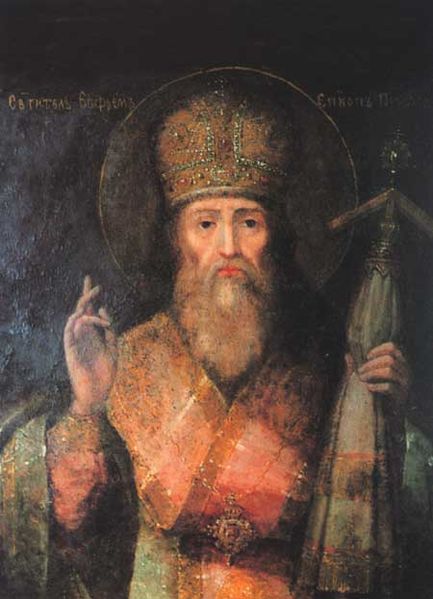 Saint Ephraim of the Caves, Bishop of Pereslavl, before his tonsure into monasticism, was treasurer and steward of household affairs at the court of the Kiev Great Prince Izyaslav (Demetrius) Yaroslavich (1054-1068). Weighed down by this noisy and bustling life and wishng to become a monk, he was accepted by St Anthony of the Kiev Caves and was tonsured by St Nikon (March 23).
The enraged prince demanded that Ephraim return, threatening to lock him up in prison and to destroy the Monastery of the Caves. St Anthony and the brethren left the monastery and decided to go to another place. Izyaslav, however, feared the wrath of God. He took his wife’s advice and withdrew his forces from the monastery in disgrace.
St Ephraim wished to go on pilgrimage to the holy places abroad. With the blessing of St Anthony, he journeyed to Constantinople and settled there in one of the monasteries. While in Constantinople, St Ephraim made a copy of the Studite monastic Rule, and took it to Kiev at the request of St Theodosius. As soon as he received the Rule, St Theodosius implemented it in his monastery.
After the year 1072 Ephraim was made bishop in Pereslavl, with the title of Metropolitan. He adorned Pereslavl with many beautiful churches and public buildings, and he built stone walls around the city in the Greek manner. He built free hospices for the poor and travelers, and constructed several public bath-houses.
In the year 1091, St Ephraim participated in the opening and solemn transfer of the relics of St Theodosius. A Life of St Ephraim existed in former times, but it has not survived. We find an account of him both in the Life of St Theodosius, and in the Russian Chronicles. A tale and encomium for St Nicholas the Wonderworker is ascribed to St Ephraim.
St Ephraim died in the year 1098. He was buried in the Antoniev (Far) Caves of the Kiev Caves monastery.
His memory is also celebrated on September 28 and on the second Sunday of Great Len Saint Ephraim of the Caves, Bishop of Pereslavl, before his tonsure into monasticism, was treasurer and steward of household affairs at the court of the Kiev Great Prince Izyaslav (Demetrius) Yaroslavich (1054-1068). Weighed down by this noisy and bustling life and wishng to become a monk, he was accepted by St Anthony of the Kiev Caves and was tonsured by St Nikon (March 23).
The enraged prince demanded that Ephraim return, threatening to lock him up in prison and to destroy the Monastery of the Caves. St Anthony and the brethren left the monastery and decided to go to another place. Izyaslav, however, feared the wrath of God. He took his wife’s advice and withdrew his forces from the monastery in disgrace.
St Ephraim wished to go on pilgrimage to the holy places abroad. With the blessing of St Anthony, he journeyed to Constantinople and settled there in one of the monasteries. While in Constantinople, St Ephraim made a copy of the Studite monastic Rule, and took it to Kiev at the request of St Theodosius. As soon as he received the Rule, St Theodosius implemented it in his monastery.
After the year 1072 Ephraim was made bishop in Pereslavl, with the title of Metropolitan. He adorned Pereslavl with many beautiful churches and public buildings, and he built stone walls around the city in the Greek manner. He built free hospices for the poor and travelers, and constructed several public bath-houses.
In the year 1091, St Ephraim participated in the opening and solemn transfer of the relics of St Theodosius. A Life of St Ephraim existed in former times, but it has not survived. We find an account of him both in the Life of St Theodosius, and in the Russian Chronicles. A tale and encomium for St Nicholas the Wonderworker is ascribed to St Ephraim.
St Ephraim died in the year 1098. He was buried in the Antoniev (Far) Caves of the Kiev Caves monastery.
His memory is also celebrated on September 28 and on the second Sunday of Great Len Venerable Ephraim, Abbot and Wonderworker of Novy Torg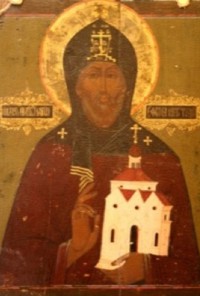 Saint Ephraim of Novy Torg, founder of the Sts Boris and Gleb monastery in the city of Novy Torg, was a native of Hungary. Together with his brothers, St Moses the Hungarian (July 26) and St George (in Hungarian “Sandor,” pronounced “Shandor”), he quit his native land, possibly because he was Orthodox.
Having come to Russia, all three brothers entered into the service of the Rostov prince St Boris, son of St Vladimir (July 15). St Ephraim’s brother George also perished in the year 1015 at the River Alta, with holy Prince Boris. The murderers cut off his head, and took the gold medallion which he had received from St Boris. Moses managed to save himself by flight, and became a monk at the Kiev Caves monastery.
St Ephraim, evidently in Rostov at this time, and arriving at the place of the murder, found the head of his brother and took it with him. Forsaking service at the princely court, St Ephraim withdrew to the River Tvertsa in order to lead a solitary monastic life.
After several other monks settled near him, he founded a monastery in honor of the holy Passion-Bearers Boris and Gleb in the year 1038. The brethren chose him to lead them. Near the monastery, not far from a merchant’s road to Novgorod, a wanderer’s home was built, where the poor and travelers stayed for free. St Ephraim died in old age. His body was buried at the monastery he founded. The head of his brother, St George was also placed in the grave, in accordance with his last wishes. The relics of St Ephraim were uncovered in the year 1572. Saint Ephraim of Novy Torg, founder of the Sts Boris and Gleb monastery in the city of Novy Torg, was a native of Hungary. Together with his brothers, St Moses the Hungarian (July 26) and St George (in Hungarian “Sandor,” pronounced “Shandor”), he quit his native land, possibly because he was Orthodox.
Having come to Russia, all three brothers entered into the service of the Rostov prince St Boris, son of St Vladimir (July 15). St Ephraim’s brother George also perished in the year 1015 at the River Alta, with holy Prince Boris. The murderers cut off his head, and took the gold medallion which he had received from St Boris. Moses managed to save himself by flight, and became a monk at the Kiev Caves monastery.
St Ephraim, evidently in Rostov at this time, and arriving at the place of the murder, found the head of his brother and took it with him. Forsaking service at the princely court, St Ephraim withdrew to the River Tvertsa in order to lead a solitary monastic life.
After several other monks settled near him, he founded a monastery in honor of the holy Passion-Bearers Boris and Gleb in the year 1038. The brethren chose him to lead them. Near the monastery, not far from a merchant’s road to Novgorod, a wanderer’s home was built, where the poor and travelers stayed for free. St Ephraim died in old age. His body was buried at the monastery he founded. The head of his brother, St George was also placed in the grave, in accordance with his last wishes. The relics of St Ephraim were uncovered in the year 1572. The Holy Two MartyrsMother and daughter, by the sword
Martyr Charita
Venerable Theodosius the Abbot of Totma, Vologda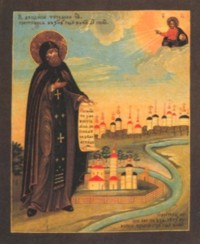 Saint Theodosius of Totma was born at Vologda about the year 1530. In his youth he was raised in a spirit of Christian piety and the fear of God. At the insistence of his parents he married, but family life did not turn him away from God. He went fervently to church and prayed at home, particularly at night. After the death of his parents and his wife, he withdrew to the Priluki monastery not far from Vologda.
At the monastery Theodosius passed through the various obediences: he carried water, chopped fire-wood, milled flour and baked bread. He went to Totma on the igumen’s orders to search for a salt-works for the monastery. He sought the permission of Tsar Ivan Vasilevich and the blessing of Archbishop Nicander to found a monastery at Totma. Theodosius was appointed head of this newly-formed Totma monastery, which in a grant of 1554 was declared free of taxation.
The saint founded the Totma Ephraimov wilderness monastery and brought brethren into it. Eventually becoming the head of two monasteries, Theodosius continued to lead an ascetic life. He wore down his body by wearing chains and a hairshirt, and beneath his monastic cowl he wore an iron cap. Fond of spiritual reading, he acquired many books for the monastery. St Theodosius reposed in the year 1568 and was buried in the monastery he founded, and miracles occurred at his grave.
On September 2, 1796 during the reconstruction of the Ascension church, his relics were found incorrupt, and their glorification took place on January 28, 1798, on the day of his repose. Saint Theodosius of Totma was born at Vologda about the year 1530. In his youth he was raised in a spirit of Christian piety and the fear of God. At the insistence of his parents he married, but family life did not turn him away from God. He went fervently to church and prayed at home, particularly at night. After the death of his parents and his wife, he withdrew to the Priluki monastery not far from Vologda.
At the monastery Theodosius passed through the various obediences: he carried water, chopped fire-wood, milled flour and baked bread. He went to Totma on the igumen’s orders to search for a salt-works for the monastery. He sought the permission of Tsar Ivan Vasilevich and the blessing of Archbishop Nicander to found a monastery at Totma. Theodosius was appointed head of this newly-formed Totma monastery, which in a grant of 1554 was declared free of taxation.
The saint founded the Totma Ephraimov wilderness monastery and brought brethren into it. Eventually becoming the head of two monasteries, Theodosius continued to lead an ascetic life. He wore down his body by wearing chains and a hairshirt, and beneath his monastic cowl he wore an iron cap. Fond of spiritual reading, he acquired many books for the monastery. St Theodosius reposed in the year 1568 and was buried in the monastery he founded, and miracles occurred at his grave.
On September 2, 1796 during the reconstruction of the Ascension church, his relics were found incorrupt, and their glorification took place on January 28, 1798, on the day of his repose. |